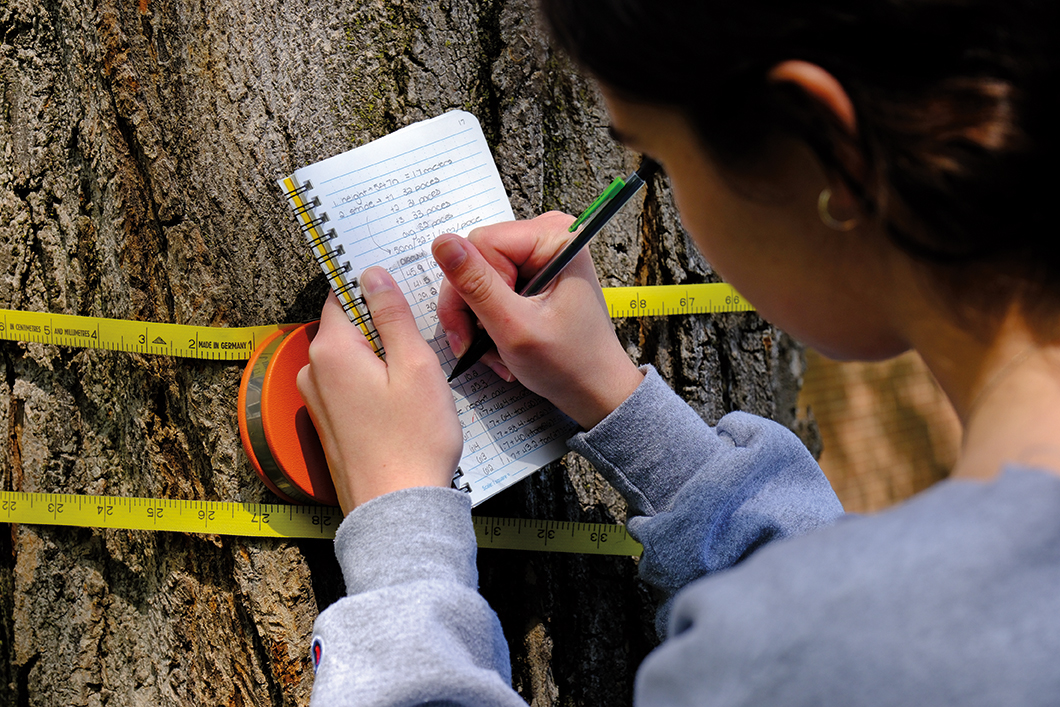‘An oasis of natural beauty’
Trinity’s campus named an urban arboretum
Kristen Cole and Andrew J. Concatelli
Nestled amid buildings and roadways in the city of Hartford, Trinity College is home to more than 1,500 trees representing dozens of species across 100 acres. In recognition of the College’s treescape, in March 2023, the independent accrediting agency ArbNet designated the campus an arboretum. Trinity joins 10 other accredited arboreta in Connecticut.
“Establishing the Trinity College Arboretum is a significant milestone in our commitment to local ecology and the culmination of years of discussion and volunteer efforts,” said Susan A. Masino, Vernon D. Roosa Professor of Applied Science. “On the eve of Trinity’s Bicentennial, we wanted to officially formalize our dedication to conserving nature for the future. Our campus is an oasis of natural beauty, and it will serve as a model for future urban arboreta and their benefits to the health of the community and beyond.”
Trinity’s campus is among hundreds of sites across more than three dozen nations that have been accredited by ArbNet. The designation recognizes sites that have met a rigorous set of industry standards.

Photo by Helder Mira
In pursuing the application, Trinity students, staff, and faculty identified and labeled 37 tree species on campus. The arboretum includes two Connecticut state champion trees—an English elm and a Temple’s Upright sugar maple—that are the largest known trees of those species in the state. Elms have long been associated with Trinity and are referenced in its alma mater, “’Neath the Elms.”
Being recognized as an arboretum will help Trinity protect and enhance this plot of urban forest and celebrate the region’s natural history by encouraging people to learn about and interact with the local environment.
The formal designation by ArbNet also shines new light on the College’s ongoing sustainability efforts. When recently developing a Sustainability Action Plan, Trinity cited stewardship of the campus as a critical part of its mission. Hayley Berliner, Trinity’s sustainability coordinator, said, “The Trinity College Arboretum reflects our enduring commitment to supporting sustainability efforts and Trinity’s strategic vision while simultaneously offering new opportunities for engagement, learning, financial support, and conservation.”
The campus itself also serves as a living laboratory for teaching and research, as in the “Introduction to Environmental Science” course taught by Jonathan R. Gourley, principal lecturer and laboratory coordinator in the Environmental Science Program. One lab exercise involves tracking the growth of trees on the Alfred C. Jacobs Life Sciences Center Quad.
“I have students measure the girth—using a tape measure to get the diameter at breast height—and estimate the height of a tree by pacing away from the tree and employing a tool called a clinometer to measure an angle, then making calculations using basic trigonometry. Now we have 10 years’ worth of student data,” said Gourley. “By making graphs, we can see these trees are growing over time. This takes a page from forestry to understand how trees are measured rapidly to estimate their size, economic value, and age.”
The hands-on experience leaves an impression on students. “Many people assume that environmental science is limited to places such as protected forests or national parks, but Professor Gourley taught us about how important environmental science is for cities,” said Avery Sands ’26, of Marshfield, Massachusetts. “Being able to investigate the trees helped me appreciate Trinity’s role as an arboretum. For an environmental science major, it is great to see that Trinity is putting in effort to protect the biodiversity here on campus.”
Sidra Hassan ’25, a biology major from Houston, Texas, noted, “The class made me realize the importance of sustainability and recycling. . . . It is imperative that trees and the environment are preserved because they regulate the other factors that are necessary for all living species to survive.”
Gourley said that Trinity’s arboretum designation is important for many reasons, including serving as a way to recognize and preserve the notable trees on campus. “Trees in urban environments are also critical for the habitats they provide urban critters, like raptors and squirrels, and for the oxygen they produce in the city through photosynthesis,” said Gourley, who added that the College owns two parcels of land in the eastern Connecticut town of Ashford that are also used for research.
The striking visual appeal of the trees on campus is another benefit not to be overlooked, Gourley said. “The beauty of this campus is not just the buildings like the Long Walk; it’s the shady trees to sit under during a warm day to read a book or the fall foliage that’s spectacular when a tree is completely orange or red, on fire with fall colors,” he said. “The walk across campus is more pleasant when trees are capturing a fresh snowfall or flowering in spring.”
Today, Trinity is caring for its existing trees while formalizing plans for new plantings on campus, Berliner said, adding that the College is committed to adding native species, including the dozen oak species native to New England. Tree additions and replacements will focus on supporting biodiversity and public health and on mitigating impacts of climate change. And as part of the Bicentennial celebration, Trinity has revived a ceremonial tradition of planting a new tree on campus every Charter Day, May 16, to mark the anniversary of the College’s founding.
For a walking tour of the Trinity College Arboretum, please visit map.trincoll.edu.
